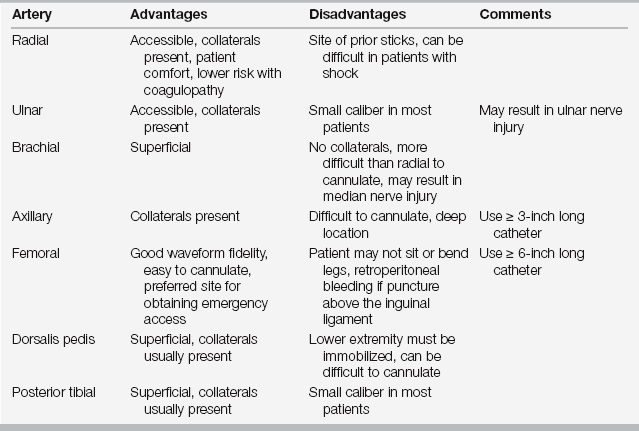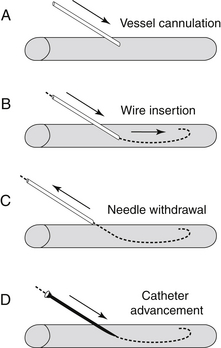Chapter 11
Vascular Access Issues and Procedures 
Bedside Ultrasonography in the ICU
Methodology
Ultrasound can be used in both static and dynamic capacities to aid in vascular access. Static ultrasound is the use of imaging to localize, characterize, and mark the vessel prior to beginning the procedure. In contrast, dynamic ultrasound uses imaging to visualize the needle and the vessel in real time during the procedure and to guide puncture of the vessel. It is optimal to apply both techniques: (1) assess vessel location and patency prior to preparing the patient and (2) perform ![]() the procedure using dynamic ultrasound guidance.
the procedure using dynamic ultrasound guidance.
Arterial Catheterization
Sites
A number of superficial arteries are used for arterial catheterization in the adult, including the radial, ulnar, brachial, axillary, femoral, dorsalis pedis, and posterior tibial arteries (Table 11.1). Although the radial artery is the most commonly used site, alternative sites may be useful in certain situations. For example, when the radial artery is not palpable, the femoral artery is an acceptable alternative. Although some ICU clinicians perform an Allen test before radial artery cannulation to document the presence of collateral circulation (via the ulnar artery), many others do not. The medical literature, including large series of patients receiving radial artery cannulation, is equivocal regarding any benefit to including this test prior to cannulation. In addition, there is no consensus on the definition or significance of an abnormal test. Clearly, after arterial catheterization of any site, the distal extremity must be monitored for signs and symptoms of ischemia. If there is concern for ischemia, the arterial catheter should be removed and a vascular surgeon should be consulted for immediate evaluation.
As with all procedures on ICU patients, the operator should observe standard safety measures prior to starting the procedures, including a “time out” or “pause” for safety, and document the pause (see Chapter 109). At a minimum, this should confirm that the following are correct: (1) the patient, (2) the procedure, and (3) the extremity and laterality (right versus left side). To perform vascular access using dynamic ultrasound, the ultrasound should be positioned in a manner that allows the practitioner easy viewing access without strain or discomfort. After the site is prepped in a standard and sterile manner, the operator dons hat, gown, and gloves. The sterile area should be draped, and ultrasound gel is placed inside a sterile plastic sleeve. An assistant then lowers the ultrasound probe into the sleeve taking care to avoid contamination of the operator, the sterile field, or the outer surface of the sleeve. The sleeve should be extended so that it covers both probe and cable, allowing the operator mobility without concern for impairing the sterility of the field. Sterile gel is then placed on the patient over the site of interest.
Insertion Methods
There are two common approaches to cannulating an artery in the ICU: direct cannulation of the vessel and the modified Seldinger technique. The direct approach involves insertion of the needle into the vessel lumen until arterial blood is identified. At this point the catheter is gently threaded over the needle into the artery. The direct approach can be used for catheterization of smaller vessels; however, it is often more difficult to perform and is not suggested for inexperienced operators.
The modified Seldinger technique is a multistage procedure (Figure 11.1). The first step involves insertion of the needle into the vessel lumen. Ultrasound guidance may be helpful during this step. The second step involves passing a thin guide wire through the needle into the lumen. After the wire is in the vessel lumen, the introducer needle is removed while the operator maintains control of the guide wire. Next, a plastic catheter is threaded over the wire into the vessel. The wire is now removed from the catheter lumen. Success is confirmed by the return of pulsatile blood from the catheter. Care should be taken to avoid traumatizing the vessel. The wire typically has a flexible, often J-shaped, tip and only this end of the wire should enter the vessel. The wire should never be advanced if resistance is met. Finally, a complication of this technique is inadvertent loss of the wire into the vessel, which can be avoided by maintaining control of some portion of the wire throughout the procedure.
The second method utilizes a separate guide wire. After puncturing the skin with the catheter and visualizing arterial blood in the reservoir, the catheter and needle are advanced slightly further so that the back wall of the artery is punctured (the so-called through-and-through technique). The needle is then removed. The catheter is very slowly withdrawn into the vessel. When pulsatile blood flow is again obtained, a small guide wire is advanced through the catheter into the vessel lumen. Finally, the catheter is advanced over the wire into the vessel.
Central Venous Catheterization
Indications
Central veins are cannulated for a variety of reasons in the ICU, including monitoring of pressure and central venous oxygen saturation as well as administration of fluids. Patients who lack suitable veins for reliable peripheral venous access often require central venous catheters. Central venous access is also indicated for the administration of vasoactive agents, hypertonic fluids, and other substances that may be injurious to peripheral veins (e.g., calcium chloride and vasopressors). Vasopressors can cause constriction and vessel injury when administered into small peripheral veins. Administering them centrally decreases the time between changes in dose and onset of effect because of the shorter “path length” between the drug infusion site and site of action. Finally, central venous access is required for pulmonary artery catheterization, temporary cardiac pacing, plasmapheresis, and hemodialysis.

Full access? Get Clinical Tree





